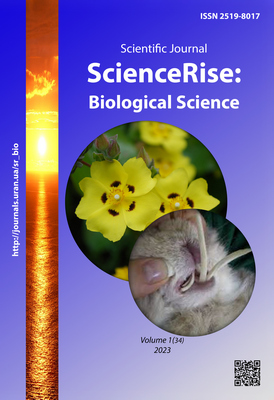Ортодонтичні корекції в гризунів та зайцеподібних: принципи та методи лікування
DOI:
https://doi.org/10.15587/2519-8025.2023.276319Ключові слова:
гризуни, зайцеподібні, денситометрія, краніометрія, ортодонтія, стоматологія, діагностикаАнотація
Мета: Наш особливий інтерес у цьому дослідженні полягає не лише в можливості екстраполяції досвіду ортодонтії гуманної медицини для ефективної ортодонтичної корекції у представників тваринного світу, але також можливості використання телерентгенометрії та краніометрії під час дослідження черепа гризунів і зайцеподібних тварин для ранньої доклінічної діагностики стоматологічних захворювань.
Матеріали і методи. Дані телерентгенографії (ТРГ), краніо- та гнатометрії, біохімії сполучної тканини (ГАГ, ГП, ХСТ), рентгеноскопії, денситометричних параметрів для раннього субклінічного виявлення захворювань зубів у шиншил (Chinchilla lanigera (n=20)), мурчаків. (Cavia porcellus (n=48)) та кроликів (Oryctolagus cuniculus(n=52)). Описано всі етапи ефективної корекції мезіального прикусу різців у кролів (N=5) та дистопії премолярів у мурчаків (N=5). Проведено розрахунок зусиль і точок їх прикладання, необхідних для переміщення зуба елодонтного типу. Наведено послідовні етапи створення відбитків зубів або 3D моделей, а також виготовлення незнімних ортодонтичних конструкцій, включаючи еластофор, ортодонтичні кнопки з фіксацією Enlight Ormco для різців; представлені індивідуальні позаротові пристрої з розширювальними гвинтами для премолярів.
Результати. Серед тварин із захворюваннями зубів достовірно мали місце такі анатомічні характеристики. Базальний кут нахилу основ щелеп один до одного, що характеризує вертикальне положення щелеп, збільшився на 11 %; тіло нижньої щелепи вкорочене на 18 %; висота гілок щелепи збільшилася на 17,5, а нижньощелепний кут, який вимірюється між дотичними до нижнього краю нижньої щелепи і тильною поверхнею її гілок, збільшився на 6 %. Ці дані слід розглядати разом із достовірним денситометричним зниженням щільності кісткової тканини та біохімічними змінами рівня показників стану сполучної тканини в сироватці крові. Аналіз міцності кісткової тканини кролів і мурчаків наведено в табл. 2, з якої видно, що щільність кісткової тканини із стоматологічним анамнезом статистично вірогідно відрізняється від міцності кісток без такого у кролів та мурчаків (p = 0,012 та p = 0,024 відповідно). Таким чином, метод програмної денситометрії може бути використаний для кількісної оцінки вираженості структурно-метаболічних захворювань кісткової тканини для прогнозування подальшого перебігу репаративного процесу, призначення адекватної фармакологічної корекції та контрольної оцінки лікувальних заходів.
Висновки. Дослідження дентальної патології гризунів та зайцеподібних за допомогою денситометричних, краніометричних та біохімічних методів дозволяє виявляти порушення в ранній доклінічній стадії. А екстраполяція досвіду гуманної ортодонтії вирішує питання корекції окклюзії цим видам тварин для відновлення можливості самостійного харчування
Посилання
- Mans, C., Jekl, V. (2016). Anatomy and Disorders of the Oral Cavity of Chinchillas and Degus. Veterinary Clinics of North America: Exotic Animal Practice, 19 (3), 843–869. doi: https://doi.org/10.1016/j.cvex.2016.04.007
- Minarikova, A., Hauptman, K., Jeklova, E., Knotek, Z., Jekl, V. (2015). Diseases in pet guinea pigs: a retrospective study in 1000 animals. Veterinary Record, 177 (8), 200. doi: https://doi.org/10.1136/vr.103053
- Abreu, M., Aguado, D., Benito, J., Gómez de Segura, I. A. (2012). Reduction of the sevoflurane minimum alveolar concentration induced by methadone, tramadol, butorphanol and morphine in rats. Laboratory Animals, 46 (3), 200–206. doi: https://doi.org/10.1258/la.2012.010066
- Albrecht, M., Henke, J., Tacke, S., Markert, M., Guth, B. (2014). Effects of isoflurane, ketamine-xylazine and a combination of medetomidine, midazolam and fentanyl on physiological variables continuously measured by telemetry in Wistar rats. BMC Veterinary Research, 10 (1). doi: https://doi.org/10.1186/s12917-014-0198-3
- Donnelly, T. (2016). Mice and rats as pets. Merck Veterinary Manual. Kenilworth: Merck & Co.
- Hawkins, M. G., Pascoe, P. J.; Quesenberry, K. E., Orcutt, C. J., Mans, C. et al. (Eds.) (2021). Anesthesia, analgesia and sedation of small mammals. Ferrets, Rabbits and Rodents: Clinical Medicine and Surgery. St. Louis: Elsevier, 536–558. doi: https://doi.org/10.1016/b978-0-323-48435-0.00037-x
- Birchard, S. J., Sherding, R. G. (2006). Saunders Manual of Small Animal Practice. St. Louis: Saunders Elsevier. doi: https://doi.org/10.1016/b0-7216-0422-6/x5001-3
- Antoszewska, J., Kucukkeles, N. (2011). Biomechanics of Tooth-Movement: Current Look at Orthodontic Fundamental. Principles in Contemporary Orthodontics. InTech, 584. doi: https://doi.org/10.5772/23009
- Burstonea, C. (2000). Orthodontics as a science: The role of biomechanics. American Journal of Orthodontics and Dentofacial Orthopedics, 117 (5), 598–600. doi: https://doi.org/10.1016/s0889-5406(00)70213-7
- Casaccia, G. R., Gomes, J. C., Squeff, L. R., Penedo, N. D., Elias, C. N., Gouvêa, J. P. et al. (2010). Analysis of initial movement of maxillary molars submitted to extraoral forces: a 3D study. Dental Press Journal of Orthodontics, 15 (5), 37–39. doi: https://doi.org/10.1590/s2176-94512010000500006
- Diagnosis and treatment of oral disease (2012). Nihon Jibiinkoka Gakkai Kaiho, 115 (6), 612–617. doi: https://doi.org/10.3950/jibiinkoka.115.612
- Paredes, V., Gandia, J. L, Cibrián, R. D. (2006). Digital diagnosis records in orthodontics. An overview. Med Oral Patol Oral Cir Bucal, 11 (1), E88–93.
- Timoshenko, O. P., Karpinsky, M. Yu., Veretsun, A. G. (2001). Research of diagnostic capabilities of the “X-rays” software complex. Medicine, 1, 62–64.
- Alemán-Laporte, J., Bandini, L. A., Garcia-Gomes, M. S., Zanatto, D. A., Fantoni, D. T., Amador Pereira, M. A. et al. (2019). Combination of ketamine and xylazine with opioids and acepromazine in rats: Physiological changes and their analgesic effect analysed by ultrasonic vocalization. Laboratory Animals, 54 (2), 171–182. doi: https://doi.org/10.1177/0023677219850211
- Britti, D., Crupi, R., Impellizzeri, D., Gugliandolo, E., Fusco, R., Schievano, C. et al. (2017). A novel composite formulation of palmitoylethanolamide and quercetin decreases inflammation and relieves pain in inflammatory and osteoarthritic pain models. BMC Veterinary Research, 13 (1). doi: https://doi.org/10.1186/s12917-017-1151-z
- Foley, P. L., Kendall, L. V., Turner, P. V. (2019). Clinical Management of Pain in Rodents. Comparative Medicine, 69 (6), 468–489. doi: https://doi.org/10.30802/aalas-cm-19-000048
##submission.downloads##
Опубліковано
Як цитувати
Номер
Розділ
Ліцензія
Авторське право (c) 2023 Hanna Stepanenko, Oleksandr Siehodin

Ця робота ліцензується відповідно до Creative Commons Attribution 4.0 International License.
Наше видання використовує положення про авторські права Creative Commons CC BY для журналів відкритого доступу.
Автори, які публікуються у цьому журналі, погоджуються з наступними умовами:
1. Автори залишають за собою право на авторство своєї роботи та передають журналу право першої публікації цієї роботи на умовах ліцензії Creative Commons CC BY, котра дозволяє іншим особам вільно розповсюджувати опубліковану роботу з обов'язковим посиланням на авторів оригінальної роботи та першу публікацію роботи у цьому журналі.
2. Автори мають право укладати самостійні додаткові угоди щодо неексклюзивного розповсюдження роботи у тому вигляді, в якому вона була опублікована цим журналом (наприклад, розміщувати роботу в електронному сховищі установи або публікувати у складі монографії), за умови збереження посилання на першу публікацію роботи у цьому журналі.










